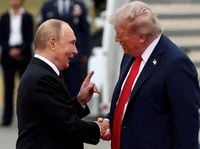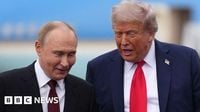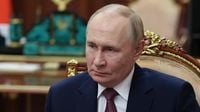Plans for a much-anticipated summit between U.S. President Donald Trump and Russian President Vladimir Putin have been abruptly shelved, with both Washington and Moscow signaling that no meeting will occur in the immediate future. The development, announced on October 21, 2025, throws a wrench into diplomatic efforts aimed at ending the grinding war in Ukraine, which is now approaching its fourth year.
Just last week, Trump had confidently told reporters that he and Putin would meet in Budapest within a fortnight to discuss a possible ceasefire. The announcement, which came after a phone call between the two leaders on October 16, reignited hopes for a breakthrough—hopes that have now been dashed. According to a senior White House official quoted by Al Jazeera, “There are no plans for President Trump to meet with President Putin in the immediate future.”
The Kremlin, for its part, downplayed the notion that a summit was ever firmly on the calendar. Dmitry Peskov, Putin’s spokesperson, told reporters, “No precise timeframe was initially set here. Preparation is needed, serious preparation.” This sentiment was echoed in Washington, where officials cited the need for more groundwork before any high-level talks could proceed.
The immediate catalyst for the postponement appears to have been a phone call on October 20 between U.S. Secretary of State Marco Rubio and Russian Foreign Minister Sergey Lavrov. The conversation was described as "productive," but the White House concluded that an in-person meeting between the two was unnecessary at this stage. As a result, the Budapest summit was quietly called off.
At an Oval Office event celebrating Diwali, Trump addressed the situation with characteristic candor. “I don’t want to have a wasted meeting. I don’t want to have a waste of time so I’ll see what happens,” he said, as reported by ABC News. Pressed on what had changed since his initial announcement, Trump demurred, saying, “Well, I didn’t say anything. I didn’t say it would. And, you know, you never know what’s going to happen. But a lot of things are happening on that front, on the war front with Ukraine and Russia. And we’ll be notified over the next two days as to what we’re doing.”
Behind the scenes, the delay is rooted in deep disagreements over the terms for ending the conflict. According to Reuters, Russia recently sent a private communique to the U.S. demanding control of all of Ukraine’s Donbas region—a nonstarter for both Trump and Ukrainian President Volodymyr Zelenskyy. Trump has publicly denied insisting that Ukraine surrender the entire Donbas, instead advocating for a freeze of the war along current battle lines. “Well, they could,” Trump said when asked if Ukraine might reclaim all occupied territory. “They could still win it. I don’t think they will but they could still win it. I never said they would win it. I said they -- anything can happen. You know war is a very strange thing. A lot of bad things happen. A lot of good things happen.”
European leaders, meanwhile, have expressed relief at the delay, wary that any rushed deal could force Ukraine into unacceptable concessions. As AP reported, leaders from the U.K., France, and Germany have all voiced opposition to any peace plan that would require Ukraine to cede land captured by Russian forces. They argue that freezing the conflict on current lines could leave occupied areas as launchpads for future Russian aggression. In a joint statement with Zelenskyy and several European heads of government, the leaders declared, “We strongly support President Trump’s position that the fighting should stop immediately, and that the current line of contact should be the starting point of negotiations. We can all see that Putin continues to choose violence and destruction.”
The diplomatic impasse comes as Ukraine continues to press for advanced weaponry from the U.S., particularly long-range Tomahawk cruise missiles. Zelenskyy met with Trump at the White House on October 17 to make his case, but the administration declined to provide the missiles—at least for now. Zelenskyy, however, remained upbeat about the talks, describing them as positive and suggesting the issue was “not off the table.” In a Telegram post on October 21, Zelenskyy emphasized, “We need to end this war, and only pressure will lead to peace.” He also accused Russia of returning to diplomacy only when the threat of new weapons loomed, and then seeking to delay talks once the pressure eased.
Russia’s position has remained steadfast, if uncompromising. Lavrov, speaking to Russian state media on October 21, criticized what he described as Washington’s insistence on halting discussions and letting “history decide.” He argued, “If we just stop, we will forget about the root causes of this conflict, which the American administration clearly understood when Donald Trump came to power.” Lavrov also dismissed reports of any shift in Moscow’s stance, telling reporters, “Russia has not changed its position compared to the understandings that were reached during the Alaska summit.” That August 2025 summit, held in Anchorage, saw the two sides agree on the need for a settlement but left major issues unresolved—chief among them Russia’s demands for Ukrainian neutrality and the dismantling of Kyiv’s military capabilities.
For Trump, the failed summit is the latest twist in a year marked by shifting strategies and mixed messages. Early in 2025, the president pressed Ukraine to make territorial concessions, but as the months wore on and Putin remained intransigent, Trump appeared to lose patience. By October, he was advocating for a freeze of the current battle lines, only to briefly float the idea of “cutting up” the Donbas region and leaving most of it in Russian hands—a suggestion that drew swift condemnation from Kyiv and its allies.
The diplomatic limbo is likely to persist in the near term. Trump is set to meet NATO Secretary-General Mark Rutte on October 22 in Washington to discuss the Ukraine war, ahead of a Coalition of the Willing meeting in London on October 24. Meanwhile, European Union leaders are preparing for a summit in Brussels to consider additional sanctions on Russia—a move aimed at increasing the economic pressure on Moscow and, perhaps, nudging Putin toward serious negotiations.
As the war in Ukraine drags on, the path to peace remains fraught with obstacles. With both sides entrenched and international diplomacy at a standstill, the world watches and waits for the next move in a conflict that has already exacted a heavy toll on Ukraine and tested the resolve of its allies.


